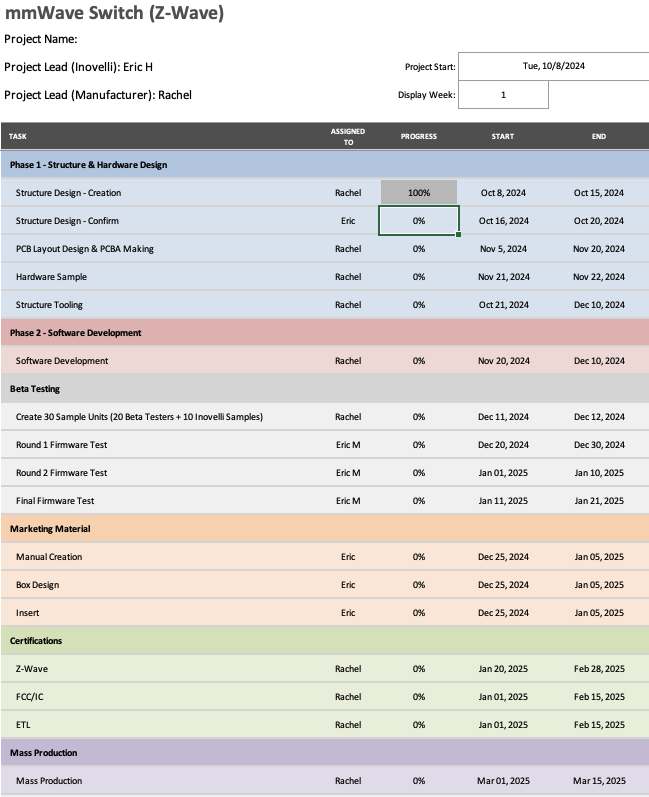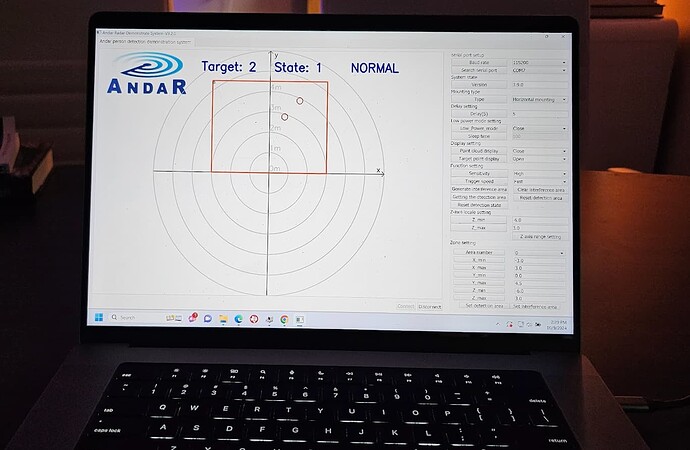Ah, then those are definitely Zigbee. They added Z-Wave as a stretch goal later. You will do well to email support to clarify your wishes.
Project update (I’m going to copy/paste most of what was mentioned on the Zigbee update):
Hey all, project update time!
I appreciate all the responses, both positive and constructive ones. It’s always nerve wracking for me to post disappointing news as these projects are basically what I pour most of my time into and it sucks when they go south. Especially this one as there’s a lot of pressure on it – but it’s the risk we took and I’m not letting it fail.
That said, I have some good news which I’ve been excited to share.
I’ve had a chance (along with @EricM_Inovelli) to test the new sensor and it is night and day what we experienced and, quite honestly, how I expected mmWave to perform when I first heard of the technology.
Here’s what we’ve tested so far and then I’ll give the update:
Zones
This was the biggest improvement and what we were missing before. The sensor has the ability to set interference zones from an x, y, and z axis. What this means is that the problems with the sensor going through walls and floors detecting people can now be blocked off left to right, top and bottom and via depth.
Here’s an example:
The left side of the screen is a yellowish square, will not detect anything that goes in that area. The red square is the target detection area where I currently was sleeping (or in this case, about to go to sleep). The red circle is me and it can track me moving across the room.
You can set up to 4 different interference zones and customize the detection zone, making this pretty robust in eliminating false positives.
Think of it this way:
- Interference Zones = Use this if you have a something that’s in the middle of the detection zone. In other words, if you want your detection zone to be 6 meters by 6 meters, but you have something in the middle of the room (floor fan) you would set an interference zone.
- Detection Zone = Use this if you want to eliminate any detection across the x, y, or z plane. A use case would be if you have a ceiling fan at the 5 meter mark and do not see the need to detect anything else at or above the 5 meter mark. You would simply set the detection zone to only detect motion up to 5 meters (or slightly below) rather than setting an interference zone just for the ceiling fan
People Tracking
The sensor can detect where you are in the room and it works great and while the sensor can technically detect up to 3 people, this is more of a beta feature right now per the manufacturer of the mmWave sensor. Single person tracking has worked 100% of the time, whereas multiple people tracking has worked about 90% of the time for me, so I don’t want to guarantee this one yet.
Here’s an example of multi-person tracking (single-person tracking was shown in the screenshot above):
In this example, I had Courtney come into my office and it showed me (at the 3m mark) sitting at my desk, whereas Courtney is shown at the 4m mark).
Breathing Detection
The sensor can detect breathing and I’ve tested this by having it track my sleeping for the past 3 nights and it has never not detected me. It even showed in the logs me getting out of bed to go to the bathroom haha.
Eric M tested it in his bedroom with his wife and it detected both of them.
So, this is huge news because our other sensor would fail if we sat too still for a period of time and the manufacturer’s solution was to increase the timeout time (terrible advice).
–
As for the specs, here are the official specs of the mmWave sensor:
- 60 GHz mmWave Sensor
- 2T2R PCB microband antenna
- ARM Cortex -M3 kernel
- FoV is 120 degrees
For the manufacturer of the mmWave sensor, I’m not going to disclose that just yet (I will once they’re in market as I don’t need to give the competition a head start), but just know that it’s one that’s touted all over the Home Assistant forums and used by a lot of the custom mmWave sensors you see in those forums. They were the original manufacturer that we wanted to go with because our testing (we tested a 24 GHz model) was nothing but positive, but the switch manufacturer talked us out of it (looking back, it was one of the worst mistakes I’ve made not listening to our gut). They are constantly innovating and have a ton of sensors developed already. I’m sure those that are following mmWave sensor manufacturers or have seen any of the custom sensor videos will know who this company is.
–
Anyway, I have officially moved on from the original manufacturer and have sent a purchase order to the new manufacturer (our current one that makes all of our switches) and their ETA for production is March 2025.
Full timeline below (which I will also update):

The structure design was sent to me yesterday and I’m having them make a couple adjustments so that the switches will work if installed with a mud-ring as this was an issue I ran into when installing our current switches at a large B2B project. I should receive an updated file tonight or tomorrow night.
For more info on the structure design please see this link: Zigbee / Matter Motion Switch | Project Linus (Blue Series) - #592 by Eric_Inovelli
Hey my bad, I was just going through the comments and missed this one. So our original design didn’t have the ability to have zones (one of the main reasons we decided to move a different direction), it just had the ability to change the depth.
Longer, more in depth explanation here: Zigbee / Matter Motion Switch | Project Linus (Blue Series) - #558 by Eric_Inovelli
However, moving to the new sensor allows for all sorts of customizations with zones (more info here: Z-Wave 800 Series Motion Switch | Project Linus (Red Series) - #82 by Eric_Inovelli)
How we’re going to implement this? I’ll have to defer to @EricM_Inovelli on this one, but we are still working on the firmware as the new manufacturer just got this project, so we may not know the answer to this yet.
In other words, the ability for zoning and excluding certain areas (as well as a whole slew of other parameters that weren’t available before) are included in the mmWave sensor – the challenge is just as you laid out… how do we convert these to parameters?
There’s definitely a need for a switch that has proper/good presence sensing functionality on the market. I already have dimmers from you guys and love them and was looking into these presence sensor switches for places such as bathrooms. For instance I have a bathroom in a “T” shape and the light switch unfortunately in the base of the T meaning that it won’t detect anything in the flat section. In a similar way, another bathroom I have is a very wide room compared to the depth which means that the FOV will severely limit detection to a very small area of the room. In the second scenario, a FOV of 150 would address the issue however. I don’t know how many rooms are such that the light switches are in the corner like this, but I can imagine that this may be a concern for some other folks when looking at purchasing these.
Any thoughts about the topic or mitigation strategies that may help alleviate some of these scenarios?
Release date? Have 5 on order.
Moved to the Red Linus Thread
Read up a couple posts.
Thanks. Read up. Bummer. Delayed from the Nov/Dec date on your web site. Ok. Will have to adjust (for now). Want all my switches in before Christmas.

